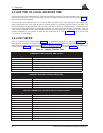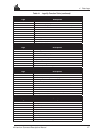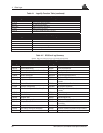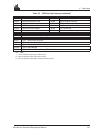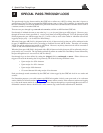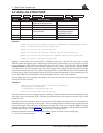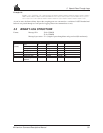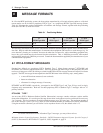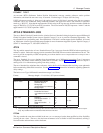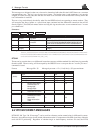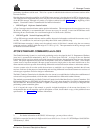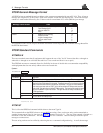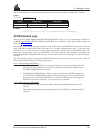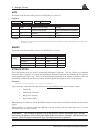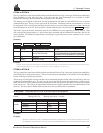
6 Message Formats
34 MiLLennium Command Descriptions Manual
6 MESSAGE FORMATS
In a NovAtel RTK positioning system, the observations transmitted by a NovAtel reference station to a NovAtel
remote station can be in either a proprietary RTCA Type 7 or a proprietary RTCM Type 59N message format.
Table 6-1 illustrates the various combinations of hardware and message formats, together with the positioning
mode (RT-20 or RT-2) which will result:
Table 6-1 Positioning Modes
The following information can be used to calculate the minimum data throughput required of the communications
data link. Keep in mind that manufacturers of communication equipment add extra bits to each message (e.g. for
error detection), forming an “overhead” that must be taken into account; also, radio transmitting equipment may
have a duty cycle which must also be factored into the calculations. Thus, a “4800 bits per second” radio modem
might actually sustain only 2000 bits per second. Consult the documentation supplied by the manufacturer of your
communications equipment.
6.1 RTCA-FORMAT MESSAGES
NovAtel has defined two proprietary RTCA Standard Type 7 binary-format messages
1
, RTCAOBS and
RTCAREF, for reference station transmissions. These can be used with either single or dual-frequency NovAtel
receivers; existing users of RT-20 wishing to switch from RTCM to RTCA message formats will require a software
upgrade. The RTCA message format outperforms the RTCM format in the following ways, among others:
• a more efficient data structure (lower overhead)
• better error detection
• allowance for a longer message, if necessary
RTCAREF and RTCAOBS, respectively, correspond to the RTCM Type 3 and Type 59 logs used in single-
frequency-only measurements. Both are NovAtel-proprietary RTCA Standard Type 7 messages with an ‘N’
primary sub-label.
RTCAOBS TYPE 7
An
RTCAOBS (RTCA Reference-Station Satellite Observations) message contains reference station satellite
observation information. It is used to provide range observations to the remote receiver, and should be sent every
1 or 2 seconds. This log is made up of variable-length messages up to 255 bytes long. The maximum number of
bits in this message is [140 + (92 x N)], where N is the maximum number of satellite record entries transmitted.
Using the
RTKMODE command, you can define N to be anywhere from 4 to 20; the default value is 12.
1. For further information on RTCA Standard Type 7 messages, you may wish to refer to:
Minimum Aviation System Performance Standards - DGNSS Instrument Approach System: Special Category I
(SCAT-I), Document No. RTCA/DO-217 (April 19, 1995); Appendix A, page 21
Reference station:
L1
RTCM Type 59N
Reference station:
L1
RTCA Type 7
Reference station:
L1 & L2
RTCM Type 59N
Reference station:
L1 & L2
RTCA Type 7
Remote station:
L1
RT-20 RT-20 RT-20 RT-20
Remote station:
L1 & L2
RT-20 RT-20 RT-20 RT-2
6 MESSAGE FORMATS



